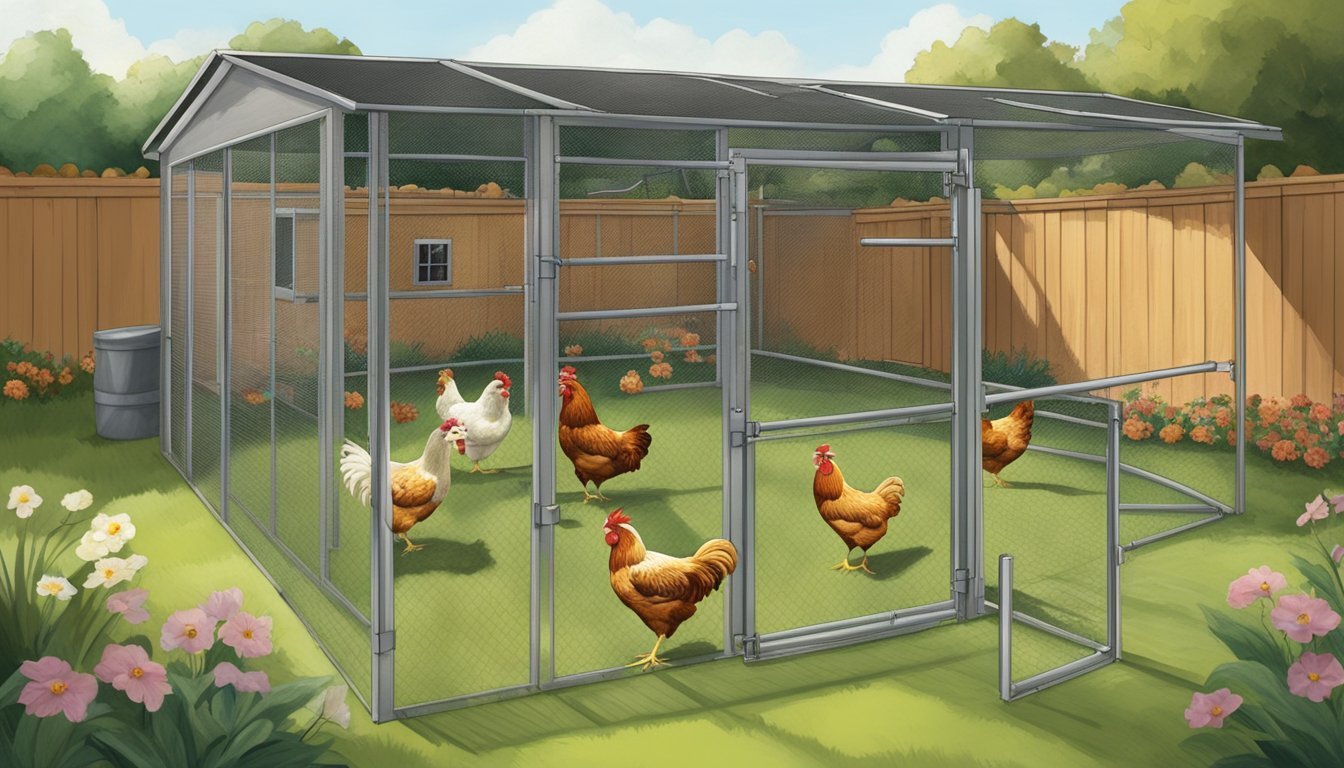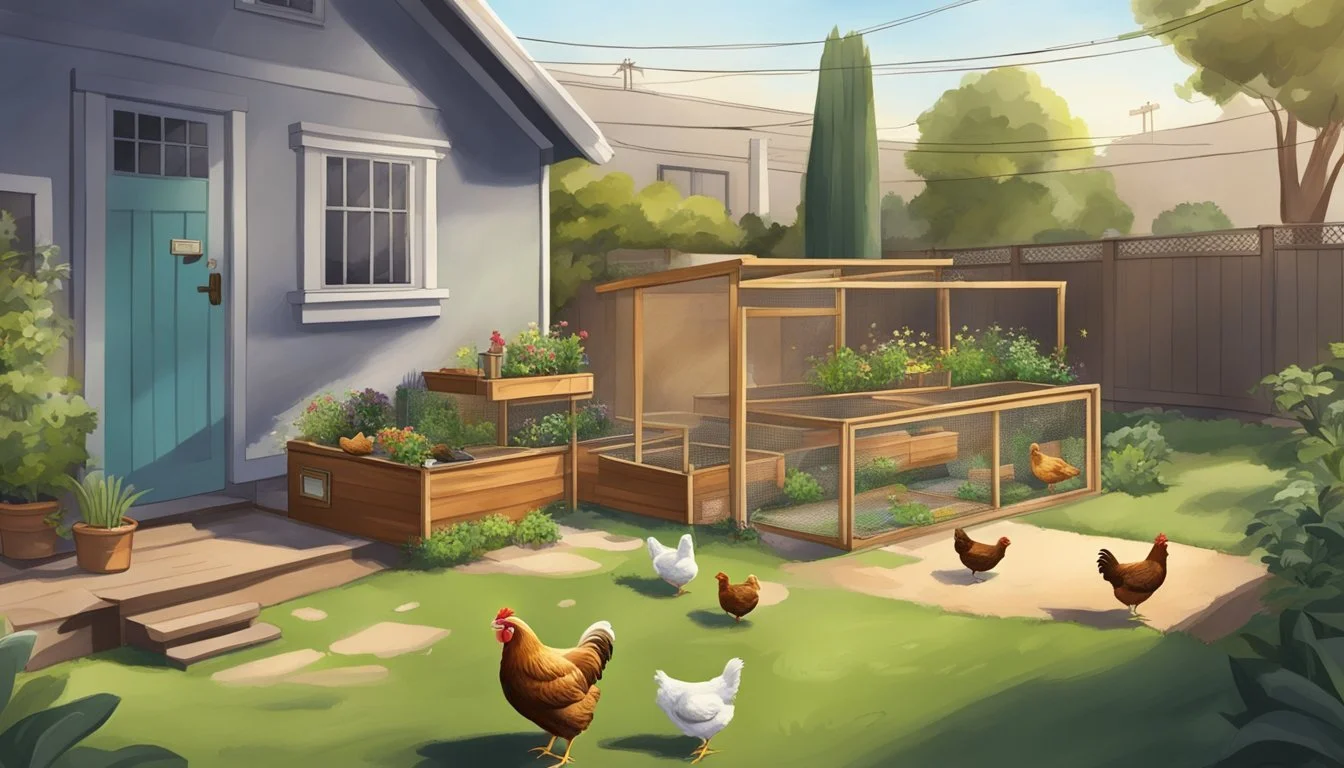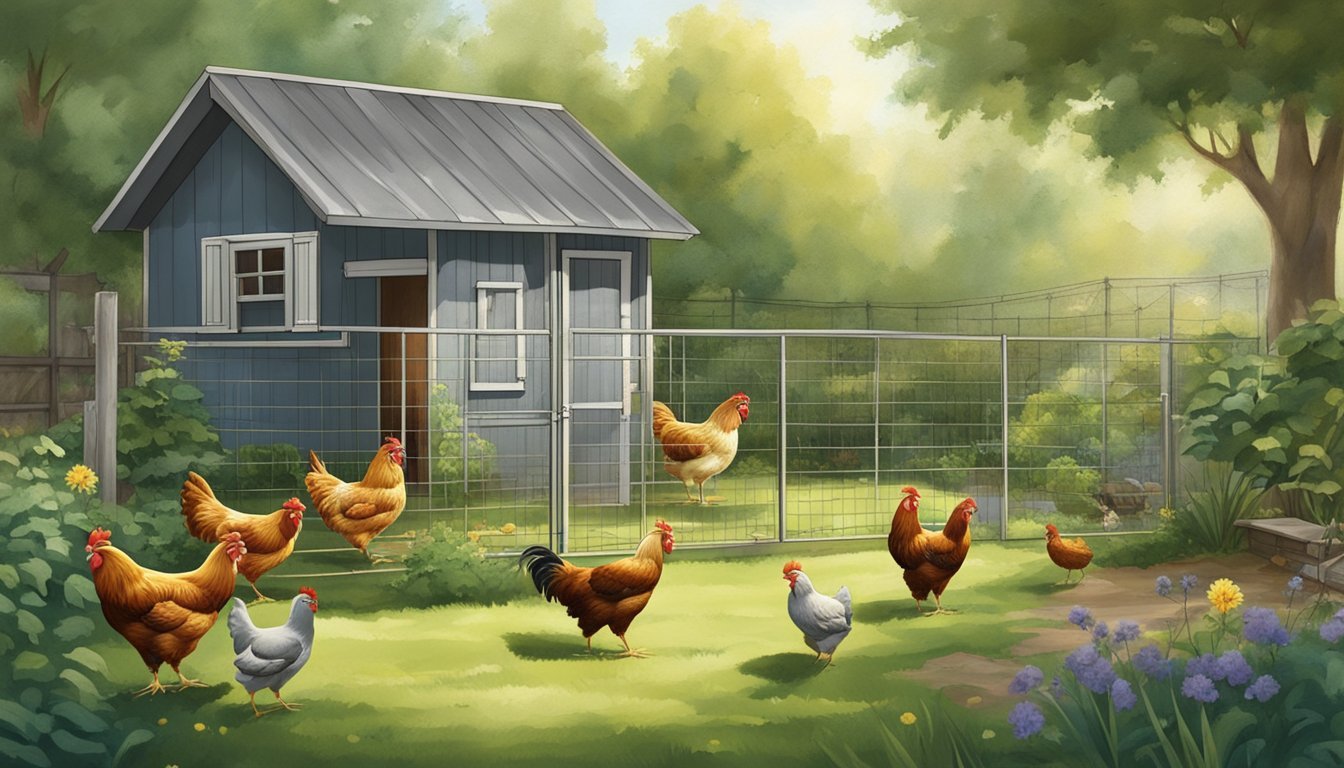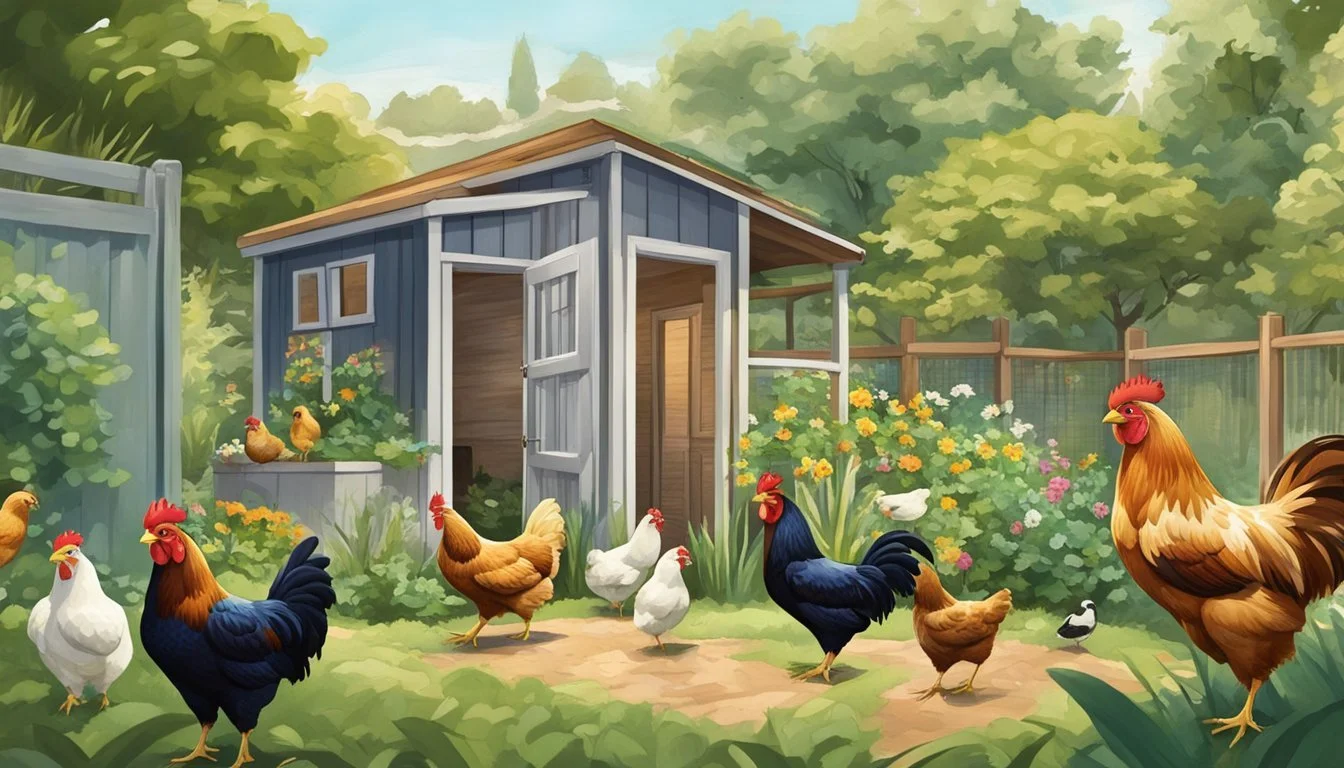Keeping Backyard Chickens in Los Angeles, CA
Rules and Tips for Urban Poultry Farming
Keeping backyard chickens (how long does chicken last?) has become increasingly popular in Los Angeles, California, reflecting a larger trend towards urban homesteading and sustainability. The city of Los Angeles permits residents to keep chickens under certain conditions which aim to respect both the welfare of the chickens and the rights of neighbors.
In Los Angeles, residents are allowed to keep up to four chickens on their property. However, those interested in raising chickens must ensure that their coops are at least 35 feet away from neighboring dwellings. If a rooster is part of the plan, additional distance is required, with coops needing to be at least 100 feet away from neighboring structures. Moreover, the city stipulates that only one rooster is allowed per property to minimize noise concerns.
It is essential for Los Angeles residents to familiarize themselves with local ordinances and requirements for backyard chicken keeping. While the rules provide a framework for maintaining chickens in the city, prospective chicken keepers must consider their capacity to provide proper care, including adequate space, nutrition, and protection from predators. Engaging with local resources and workshops can be an excellent way for residents to gain the necessary knowledge to successfully raise backyard chickens.
Basics of Backyard Chicken Keeping
Keeping backyard chickens in Los Angeles requires an understanding of local ordinances and choosing the right breed for your environment and needs. Adherence to regulations and careful selection of chickens can lead to a successful and rewarding experience.
Understanding the Local Ordinances
In Los Angeles, residents are permitted to keep poultry with certain restrictions. The local ordinance allows:
The keeping of poultry provided they are not kept for commercial purposes.
Up to five swine may also be kept, although this is less common for urban backyard settings.
Important note: These animals must be part of residential use of the lot and should not cause a nuisance. It is essential for potential chicken owners to ensure that their chicken-keeping practices align with the specified rules to avoid legal issues.
Selecting the Right Chicken Breed
When selecting a breed of chicken for a backyard in Los Angeles, potential owners should consider factors like temperament, egg production, and climate suitability. Here are some aspects to keep in mind:
Temperament: Some breeds are more docile and better suited for close quarters, which is beneficial in urban environments.
Egg Production: Productive breeds like the Rhode Island Red or Plymouth Rock can offer a steady supply of eggs.
Climate Suitability: Breeds that can tolerate the warm Los Angeles climate, such as the Leghorn or Australorp, are advisable choices.
For optimal success, prospective owners should choose breeds that are known for their ability to adapt to the specific conditions found in Los Angeles backyards.
Legal Considerations
When keeping backyard chickens in Los Angeles, it is crucial for residents to understand local regulations that pertain to zoning, permits, and community relations. Failure to comply can result in fines or the removal of the chickens.
Navigating Zoning and Permits
Los Angeles residential areas have specific zoning laws that determine where chickens can be legally kept. Backyard chickens are allowed in zones RA, RE, RS, R1, RU, and RZ, under the condition that they are not kept for commercial purposes. Distance requirements further stipulate that chicken coops must be at least 20 feet from the owner's residence and 35 feet from neighboring residences. Moreover, coops should be situated no less than 10 feet from any side or rear lot lines.
While some municipalities may not require a permit to keep backyard chickens, Los Angeles residents should verify with the Department of Animal Services or local planning departments to confirm if a permit is needed. Adherence to these restrictions ensures responsible chicken ownership and minimizes conflicts within the community.
Neighbor Relations and Nuisance Issues
Maintaining a good relationship with neighbors is essential when raising chickens in an urban environment. Key nuisance issues to manage include sanitation, noise, and odors. In particular, Los Angeles limits households to one rooster per property, due to their potential to cause noise disturbance.
Chicken waste management is critical and must be addressed properly to prevent health risks and odors. The city recommends composting as an effective waste management practice. Residents should be aware that failure to maintain proper sanitation could be considered a nuisance, potentially inviting intervention from the Department of Animal Services.
By understanding and respecting these legal considerations, Los Angeles residents can enjoy raising backyard chickens while maintaining a harmonious urban community.
Setting Up Your Coop
When embarking on the journey of keeping backyard chickens in Los Angeles, CA, it's crucial to prioritize the design and location of your coop to ensure the well-being of your chickens and compliance with local regulations.
Space and Location
Adequate space is a non-negotiable aspect of chicken coop setup. Each chicken requires at least 2-3 square feet inside the coop for comfort and to prevent overcrowding, as well as 8-10 square feet in an outdoor area for free movement. The location of your coop must adhere to municipality setbacks; Los Angeles ordinances stipulate that the coop must be at least 35 feet away from neighboring structures.
Minimum Inside Space per Chicken: 2-3 square feet
Minimum Outside Space per Chicken: 8-10 square feet
Setback Requirements: 35 feet from neighboring structures
The coop should be positioned in a part of the yard that provides protection from predators and extreme weather conditions. It should also be easily accessible for cleaning and maintenance.
Coop Design and Amenities
The design of your chicken coop should prioritize safety and comfort. Ensure that it is well-ventilated to maintain a healthy air quality and to manage temperature extremes, yet draft-free to prevent illness among the flock.
Ventilation: Crucial for air quality and temperature control
Protection: Secure against predators and weather
The coop should include nesting boxes for the hens to lay their eggs and sufficient roosting space for all chickens to sleep comfortably off the ground. Typically, provide one nesting box for every three hens, and 8-12 inches of roosting bar per chicken.
Nesting Boxes: 1 per 3 hens
Roosting Space: 8-12 inches per chicken
Roosters are often not necessary unless the goal is to fertilize eggs, and in some cases, they may be restricted by local noise ordinances. Be sure to verify local regulations regarding rooster ownership, as many urban environments have specific rules about keeping them.
When designing and setting up your coop, always check with the relevant municipality to ensure full compliance with all local laws and regulations.
Chicken Care and Management
In Los Angeles, keeping backyard chickens requires knowledge of proper feeding, vigilant health and disease prevention, and measures to protect against predators. These aspects are crucial for the well-being of the chickens and ensure they thrive in an urban setting.
Feeding and Nutrition
Chickens require a balanced diet to maintain their health and egg production. It's important to provide chickens with:
Starter Feed: Rich in protein, this feed is essential for chicks up to 8 weeks old.
Grower Feed: Lower protein content and introduced from 8 weeks until they start laying eggs.
Layer Feed: Increased calcium levels to support eggshell integrity for laying hens.
Feeding backyard chickens also involves clean, fresh water available at all times, and a regulated feeding schedule to keep the chickens in optimal health.
Health and Disease Prevention
Backyard chickens in Los Angeles need regular health checks to prevent the spread of disease. Key practices include:
Sanitation: Regularly cleaning the coop and providing a clean living environment.
Vaccination: Protecting chickens against common ailments.
Parasite Control: Routine checks for lice, mites, and other parasites.
Preventing contact with wild birds and rodents helps in minimizing disease risk. Chicken owners should be aware of common poultry diseases and seek veterinary guidance when health issues arise.
Predator Protection
Chickens are at risk from various predators in urban environments. To safeguard your flock:
Structural Integrity: Ensuring the coop and run are secure with no gaps or weak points.
Locking Mechanisms: Installing locks on doors and nesting boxes to prevent access by raccoons and other clever predators.
Night Safety: Encouraging chickens to return to the coop at dusk and securing the coop nightly.
By employing these protective measures, chicken owners can deter common predators like coyotes, hawks, and neighborhood pets.
Raising Chickens at Home
Raising chickens at home in Los Angeles, CA, involves understanding local ordinances and providing proper care from incubation to adulthood, ensuring both chicks and adult chickens live in a suitable environment.
Incubating Eggs and Raising Chicks
When starting with incubating eggs, one needs a reliable incubator that maintains consistent temperature and humidity. Post-hatch, chicks require a warm and secure brooder for the first few weeks of life. Essential brooder elements include:
Heat source: Maintain a temperature of 95 degrees Fahrenheit in the first week and reduce by 5 degrees each subsequent week.
Bedding: Pine shavings or similar absorbent materials must be used.
Food and water: Starter feed and clean water should be accessible at all times.
It's important to monitor chicks closely, ensuring the brooder doesn’t become overcrowded as they grow.
Managing Adult Chickens
Once chickens mature, they need a coop that provides protection and space for them to roam. Coop essentials include:
Nesting boxes: One box for every three hens.
Perches: Adequate space for roosting.
Security: Protection from predators and extreme weather.
The number of chickens one can keep is not limited by Los Angeles city code as long as space is sufficient — they must be at least 20 feet away from the owner's residence and 35 feet from neighboring dwellings. Chickens should be considered part of your overall livestock management plan, with considerations for their health, hygiene, and the local environment.
Additional Considerations
When managing backyard chickens in Los Angeles, careful attention must be paid to not only the legalities but also to sustainable practices and egg handling to ensure a successful and responsible poultry endeavor.
Egg Collection and Usage
Los Angeles residents who engage in backyard poultry farming often enjoy the benefit of free-range eggs, which are typically fresher and can be more nutritious than their store-bought counterparts. Eggs should be collected daily to avoid spoilage. It's also important to note that while residents may consume the eggs their chickens produce, selling eggs or meat may be subject to additional health and safety regulations.
Sustainability and Composting
Sustainability is a key aspect of backyard chicken-keeping. Chickens play a significant role in a sustainable ecosystem; their waste can be composted and used as a nutrient-rich fertilizer for gardens. The Los Angeles Times has highlighted the growth of urban farming and the positive impact of practices such as composting. When composting chicken waste, one must ensure it is properly aged to kill potential pathogens before being used in gardens. Housing for chickens should also be designed with sustainability in mind, providing safe, clean, and spacious conditions to range your chickens and promote their natural behaviors.
Other Animals and Backyard Farming
In the expanding landscape of urban agriculture in Los Angeles, chickens are just a part of the equation. Residents often look to diversify their backyard farms with other animals, and this requires knowledge of proper cohabitation practices and pest management.
Combining Chickens with Other Farm Animals
When integrating chickens with other farm animals, such as rabbits, it is essential to consider their space requirements and compatibility. Chickens and rabbits can coexist peacefully, but separate living quarters are crucial to prevent any territorial disputes and diseases. Secure, spacious enclosures ensure that both animals can move freely without encroaching on each other's space.
Housing Requirements: Chickens need a coop for shelter and nesting, while rabbits require a hutch with adequate ventilation.
Feeding Stations: Separate feeding areas to prevent competition for food.
Behavior Monitoring: Regular observation to ensure peaceful coexistence.
Addressing Issues with Rodents and Other Pests
Rodents can be attracted to the food and shelter provided by backyard farming. Implementing proper sanitation and storage practices are key strategies to deter these pests.
Secure Feed Storage: Store chicken and rabbit feed in rodent-proof containers.
Habitat Management: Regularly clean animal enclosures to eliminate potential nesting sites.
Physical Barriers: Employ fences or wire mesh around coops and hutches to prevent entry.
Backyard farming has evolved into a growing trend in Los Angeles, with chickens and other animals like rabbits becoming more than just sources of food, but also beloved pets. Proper planning and maintenance are essential for a harmonious and healthy backyard farm.
Supplies and Accessories
When setting up a backyard chicken coop in Los Angeles, it is crucial that one acquires the appropriate supplies and accessories to ensure the health and comfort of the chickens. Having the right equipment can make a significant difference in the ease of chicken maintenance and the wellness of the flock.
Choosing the Right Equipment
For starters, feeders are essential as they determine how chickens eat. It's important to choose feeders that are appropriate for the chicken's size and reduce waste. A heating lamp or radiant heater may be necessary, especially for chicks in the brooding stage, to maintain a consistent and warm environment within the coop. Additionally, nesting boxes play a critical role in providing a safe and designated space for hens to lay eggs. They should be comfortable, easy to clean, and accessible.
Bedding Options and Maintenance
The choice of bedding impacts both the cleanliness of the coop and the health of the chickens. Here are common materials suitable for coop bedding:
Pine Shavings: Highly absorbent and with a pleasant smell, making them a popular choice.
Straw: Good insulation during colder months and fairly easy to compost.
Sand: Excellent for drainage and easy to sift through for cleaning.
Kitty Litter: Not as commonly used due to dust and potential toxicity; however, some forms such as natural, paper-based litters can be safe.
Bedding must be kept dry to prevent the growth of mold and reduce the risk of disease. Regular maintenance involves removing soiled bedding and replacing it with fresh material, while the entire coop should undergo deep cleaning periodically.










